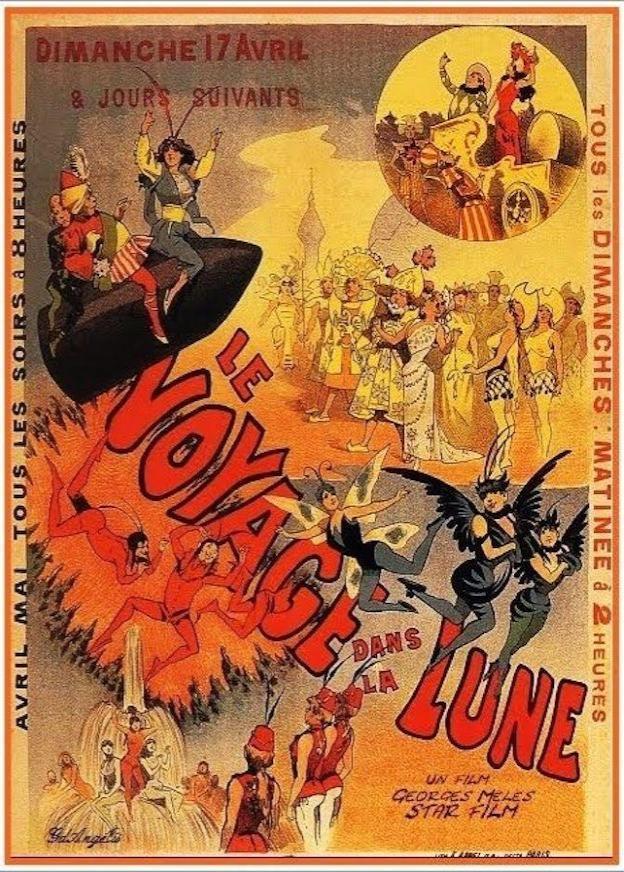A Trip to the Moon (S)

Spoiler warning: Plot and/or ending details follow: Six brave astronomers plan a voyage from Earth to the Moon. They build a space capsule in the shape of a bullet and a huge cannon to shoot it into space. The astronomers embark and their capsule is fired from the cannon with the help of a bevy of beautiful women (played by chorus girls of the Folies Bergères). The Man in the Moon watches the capsule as it approaches, and it hits him in the eye. Safely on the Moon, the explorers get out of the capsule, unroll their blankets, and take a nap. They dream of celestial Folies-Bergères girls, who call down a snowfall that wakens the explorers. The explorers seek shelter in a cavern and discover giant mushrooms. One astronomer opens his umbrella; it promptly takes root and turns into a giant mushroom itself. At this point, a Selenite (an alien inhabiting the Moon, apparently part man and part insect) appears, but it is easily killed by an astronomer (the creatures explode if whacked with a stick or umbrella). More Selenites appear and it becomes increasingly difficult for the explorers to destroy them as the creatures surround them. The Selenites arrest the astronomers and bring them to their leader. An astronomer picks the Chief Selenite up off its throne and dashes it to the ground, exploding it. The astronomers run back to their capsule (popping pursuing Selenites on the way). Five get inside. The sixth uses a rope to tip the capsule over a ledge on the Moon and into space. A Selenite tries to seize the capsule at the last minute. Astronomer, capsule, and Selenite fall through space and land in an ocean on Earth, where all are rescued by a ship and towed ashore. There is in fact a final scene of the film in which there is a celebratory parade in honor of the travellers' safe return. Parts of the final scene have been recovered but the entire scene has either been lost or withheld pending expiration of the movie's copyright. Voyage dans la Lune, Le/A Trip to the Moon (France, 1902), the screen's first science fiction story, was a 14 minute masterpiece (nearly one reel in length (about 825 feet)), created by imaginative French director and master magician Georges Méliès (1861-1938) in his version of the Jules Verne story. The silent film's plot, a light-hearted satire criticizing the conservative scientific community of its time, was inspired by Jules Verne's From the Earth to the Moon (1865) and H. G. Wells' First Men in the Moon (1901). This film, Melies' 400th and most notable film, was made on an astronomical budget for the time of 10,000 Francs - risky, but worthwhile since it was hugely successful. Its popularity also led to it being illegally copied, released under others' names, and pirated (including one stolen by Edison's film technicians and distributed throughout the US). [For example, an illegal duplicate of the film was available in the USA from Siegmund Lubin under the title A Trip to Mars.] Melies wrote the whimsical script, acted in the film in the lead role, designed the sets and costumes, directed, photographed, and produced the film! He hired acrobats from the Folies Bergere to play the lunar inhabitants named Selenites, and the scantily dressed assistants (or pages) who launched the cannon were dancers from the Châtelet ballet. The image of the lunar capsule landing in the eye of the moon is a memorable sight and widely-recognized in cinematic history. As a film pioneer and producer of over 500 short films, Melies made up and invented the film medium as he directed. He developed the art of special effects in earlier films, including double exposure, actors performing with themselves over split screens, and use of the dissolve and fade. He also pioneered the art of film editing. The sets or scenery backdrops in the film are simple, painted flats. It has all the elements that characterize the science-fiction genre: adventurous scientists, a futuristic space voyage, special effects such as superimpositions, and strange aliens in a far-off place. (information from wikipedia and filmsite.org)